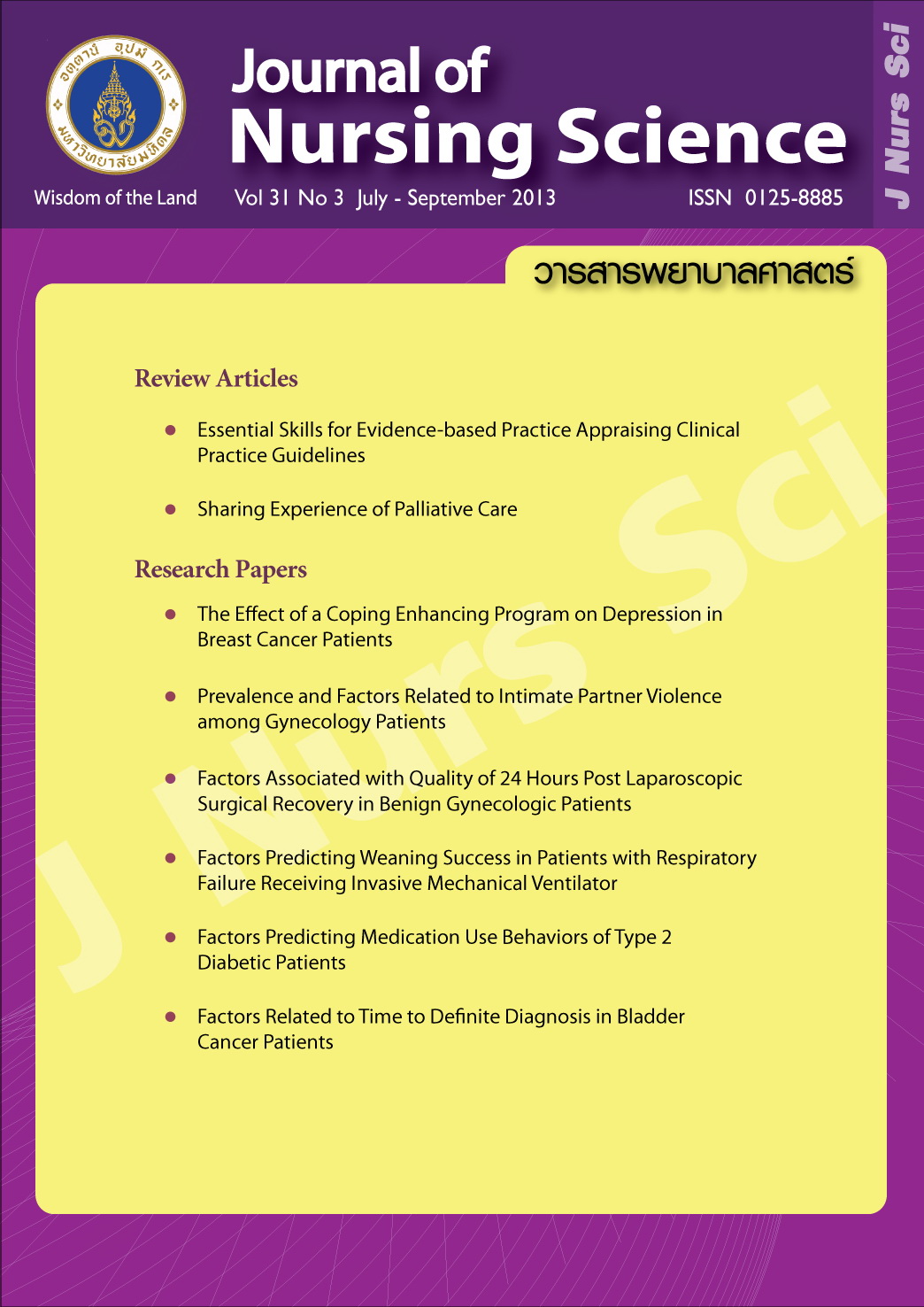Factors Predicting Medication Use Behaviors of Type 2 Diabetic Patients
Main Article Content
Abstract
Purpose: To study factors predicting medication use behaviors of type 2 diabetic patients. These factors included gender, age, education level, income, duration of disease, and beliefs related to medication use behaviors.
Design: Correlational predictive design.
Methods: The subjects consisted of 108 patients with type 2 diabetes mellitus who received diabetic medications. The questionnaires were used for data collection. The data were analyzed using descriptive statistics, Pearson’ product moment correlation coefficient, and stepwise regression technique.
Main findings: The majority of participants (99.1% vs 95.4%) in this study obtained ‘good’ levels of medication use behaviors and beliefs related to medication use behaviors in type 2 diabetic patients. Beliefs related to medication use behaviors could explain 4.3% of the variance in the medication use behaviors (R2 = .043, p < .05). Gender, age, education level, income, duration of disease could not predict medication use behaviors of type 2 diabetic patients.
Conclusion and recommendations: Based on the study’s findings, beliefs related to medication use behavior affect medication use behaviors of diabetic patients. It is recommended that intervention program or guidelines should be developed by using the concept of beliefs related to medication use behavior to ensure appropriateness and effectiveness of medication use behaviors.
ปัจจัยทำนายพฤติกรรมการใช้ยาของผู้ป่วยเบาหวานชนิดที่ 2
คลีพัตรา ไชยศรี, ศศิมา กุสุมา ณ อยุธยา, วิมลรัตน์ ภู่วราวุฒิพานิช, ธวัชชัย พีรพัฒน์ดิษฐ์
บทคัดย่อ
วัตถุประสงค์: เพื่อศึกษาอำนาจการทำนายของปัจจัยด้านเพศ อายุ ระดับการศึกษา รายได้ ระยะเวลาที่เป็นโรค และความเชื่อที่เกี่ยวข้องกับพฤติกรรมการใช้ยาต่อพฤติกรรมการใช้ยาของผู้ป่วยเบาหวานชนิดที่ 2
รูปแบบการวิจัย: การศึกษาความสัมพันธ์เชิงทำนาย
วิธีการดำเนินการวิจัย: กลุ่มตัวอย่างคือผู้ป่วยเบาหวานชนิดที่ 2 ที่ได้รับการรักษาด้วยยา 108 คน เก็บข้อมูลโดยใช้แบบสอบถาม วิเคราะห์ข้อมูลโดยใช้สถิติเชิงพรรณนา สัมประสิทธิ์สหสัมพันธ์ของเพียร์สัน และการวิเคราะห์ความถดถอยเชิงพหุแบบขั้นตอน
ผลการวิจัย: ผู้ป่วยร้อยละ 99.1 มีพฤติกรรมการใช้ยาอยู่ในระดับเหมาะสมมาก และร้อยละ 95.37 มีความเชื่อที่เกี่ยวข้องกับพฤติกรรมการใช้ยาอยู่ในระดับเหมาะสมมาก ความเชื่อที่เกี่ยวข้องกับพฤติกรรมการใช้ยา สามารถทำนายพฤติกรรมการใช้ยาของผู้ป่วยเบาหวานชนิดที่ 2 ได้ร้อยละ 4.3 (R2 = .043, p < .05) ส่วนเพศ อายุ ระดับการศึกษา รายได้ และระยะเวลาที่เป็นโรคพบว่า ไม่สามารถทำนายพฤติกรรมการใช้ยาของผู้ป่วยเบาหวานชนิดที่ 2
สรุปและข้อเสนอแนะ: ผลจากการวิจัยครั้งนี้แสดงให้เห็นว่า ความเชื่อที่เกี่ยวข้องกับพฤติกรรมการใช้ยามีอิทธิพลต่อพฤติกรรมการใช้ยาของผู้ป่วยเบาหวาน จึงควรพัฒนาแนวทางการดูแลผู้ป่วยโดยใช้แนวคิดความเชื่อที่เกี่ยวข้องกับพฤติกรรมการใช้ยา เพื่อส่งเสริมให้ผู้ป่วยมีพฤติกรรมการใช้ยาอย่างเหมาะสมและมีประสิทธิภาพมากขึ้น
คำสำคัญ: ความเชื่อ พฤติกรรมการใช้ยา โรคเบาหวานชนิดที่ 2
Article Details
Copyright Notice: Nursing Science Journal of Thailand has exclusive rights to publish and distribute the manuscript and all contents therein. Without the journal’s permission, the dissemination of the manuscript in another journal or online, and the reproduction of the manuscript for non-educational purpose are prohibited.

Disclaimer: The opinion expressed and figures provided in this journal, NSJT, are the sole responsibility of the authors. The editorial board bears no responsibility in this regard.

